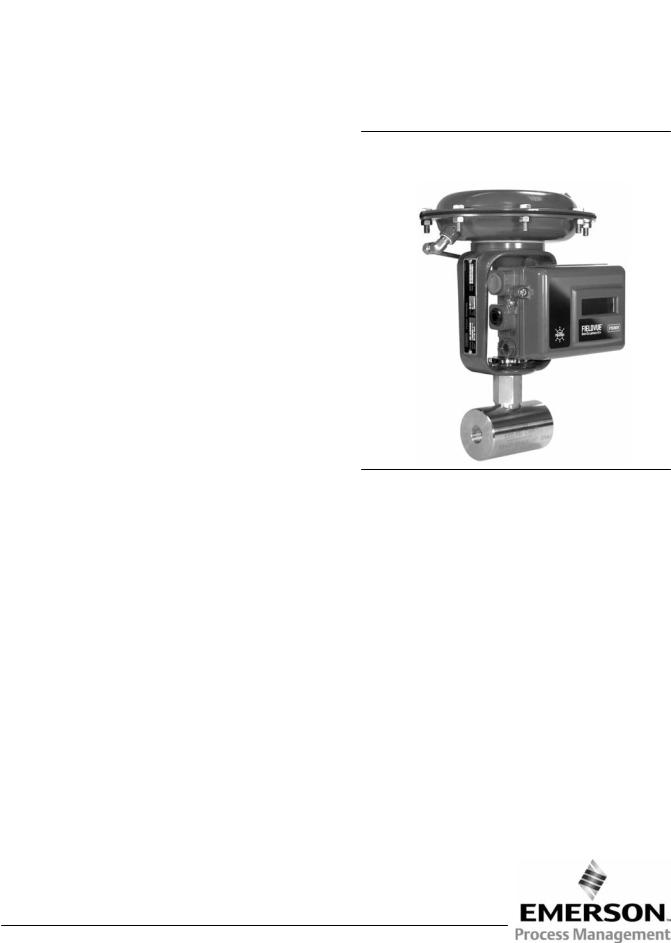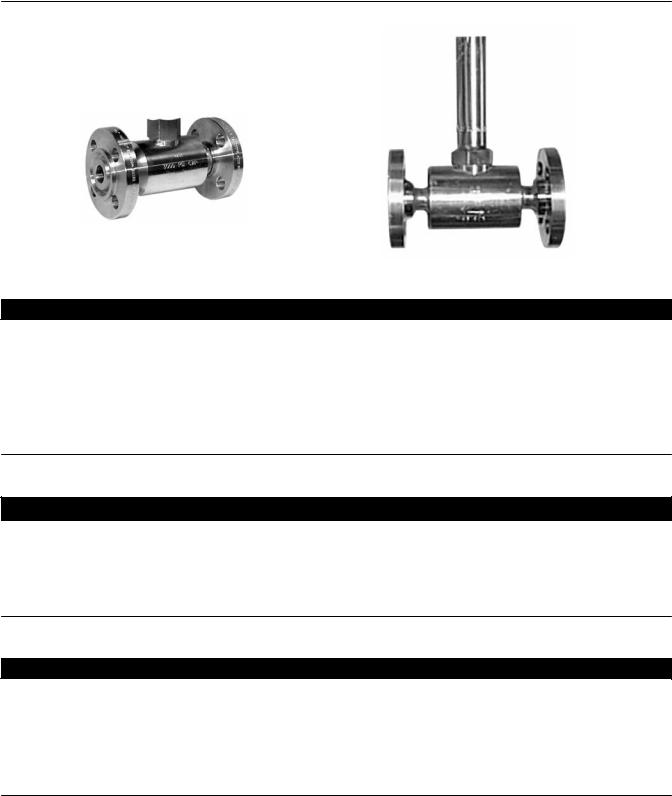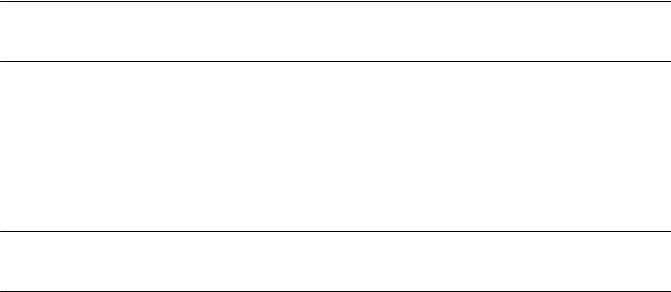Emerson Fisher Baumann 24000SB Instruction Manual

Instruction Manual |
24000SB Valve |
D103361X012 |
March 2011 |
|
|
Baumannt 24000SB Barstock Control Valve
Contents |
|
Introduction . . . . . . . . . . . . . . . . . . . . . . . . . . . . . . . . . . |
. 1 |
Scope of Manual . . . . . . . . . . . . . . . . . . . . . . . . . . . . |
. 1 |
Safety Precautions . . . . . . . . . . . . . . . . . . . . . . . . . . . |
2 |
Maintenance . . . . . . . . . . . . . . . . . . . . . . . . . . . . . . . . . |
3 |
Installation . . . . . . . . . . . . . . . . . . . . . . . . . . . . . . . . . . . |
3 |
Air Piping . . . . . . . . . . . . . . . . . . . . . . . . . . . . . . . . . . . |
4 |
Disassembly . . . . . . . . . . . . . . . . . . . . . . . . . . . . . . . . |
4 |
Lapping the Metal Seat . . . . . . . . . . . . . . . . . . . . . . . |
5 |
Replacing Packing . . . . . . . . . . . . . . . . . . . . . . . . . . . |
6 |
Actuator and Valve Body Reassembly . . . . . . . . . . . . |
6 |
Parts Ordering . . . . . . . . . . . . . . . . . . . . . . . . . . . . . . . . |
7 |
Dimensions and Weights . . . . . . . . . . . . . . . . . . . . . . |
13 |
Figure 1. 24000SB Control Valve with Baumann 32 Actuator and FIELDVUE™ DVC2000 Digital Valve Controller
W9756
Introduction
The Baumann 24000SB Barstock Control Valve (figures 1 and 2) is recommended for low flow, high pressure, industrial control applications.
Scope of Manual
This instruction manual includes installation, maintenance, and parts information for the Baumann 24000SB barstock control valve.
Do not install, operate, or maintain Baumann 24000SB control valves without being fully trained and qualified in valve, actuator, and accessory installation, operation, and maintenance. To avoid personal injury or property damage, it is important to carefully read, understand, and follow all the contents of this manual, including all safety cautions and warnings. If you have any questions about these instructions, contact your Emerson Process Management sales office before proceeding.
www.Fisher.com

24000SB Valve |
Instruction Manual |
March 2011 |
D103361X012 |
|
|
Figure 2. Baumann 24000SB Control Valve with Flanges and Extension Bonnet
W9757 |
W9758 |
|
|

 WARNING
WARNING
Always wear protective gloves, clothing and eyewear when performing any installation operations to avoid personal injury.
Personal injury or property damage caused by sudden release of pressure or bursting of pressure retaining parts may result if service conditions exceed those for which the product was intended. To avoid injury or damage, provide a relief valve for over pressure protection as required by government or accepted industry codes and good engineering practices.
Check with your process or safety engineer for any additional measures that must be taken to protect against process media.
If installing into an existing application, also refer to the WARNING at the beginning of the Maintenance section in this instruction manual.
CAUTION
This valve is intended for a specific range of pressures, temperatures and other application specifications. Applying different pressures and temperatures to the valve could result in parts damage, malfunction of the control valve or loss of control of the process. Do not expose this product to service conditions or variables other than those for which the product was intended. If you are not sure what these conditions are you should contact your Emerson Process Management sales office for more complete specifications. Provide the product serial numbers (shown on the nameplate) and all other pertinent information.

 WARNING
WARNING
If you move or work on an actuator installed on a valve with loading pressure applied, keep your hands and tools away from the stem travel path to avoid personal injury. Be especially careful when removing the stem connector to release all loading on the actuator stem whether it be from air pressure on the diaphragm or compression in the actuator springs.
Likewise take similar care when adjusting or removing any optional travel stop. Refer to the relevant actuator Maintenance Instructions.
If hoisting the valve, take care to prevent people from being injured in case the hoist or rigging slips. Be sure to use adequate sized hoists and chains or slings to handle the valve.
2

Instruction Manual |
24000SB Valve |
D103361X012 |
March 2011 |
|
|

 WARNING
WARNING
Personal injury could result from packing leakage. Valve packing is tightened before shipment; however, the packing might require some readjustment to meet specific service conditions.
Maintenance

 WARNING
WARNING
Avoid personal injury and property damage from sudden release of process pressure or bursting of parts. Before performing any maintenance operations:
D Do not remove the actuator from the valve while the valve is still pressurized.
D Always wear protective gloves, clothing, and eyewear when performing any maintenance operations.
D Disconnect any operating lines providing air pressure, electric power, or a control signal to the actuator. Be sure the actuator cannot suddenly open or close the valve.
D Use bypass valves or completely shut off the process to isolate the valve from process pressure. Relieve process pressure on both sides of the valve. Drain the process media from both sides of the valve.
D Depending on the actuator construction, it will be necessary to manage the pneumatic actuator spring pre-compression. It is essential to refer to the relevant actuator instructions in this manual to perform safe removal of the actuator from the valve.
D Use lock out procedures to be sure the above measures stay in effect while you work on the equipment.
D The valve packing box may contain process fluids that are pressurized, even when the valve has been removed from the pipeline. Process fluids may spray out under pressure when removing the packing hardware or packing rings, or when loosening the packing box pipe plug.
D Check with your process or safety engineer for any additional measures that must be taken to protect against process media.
Note
Whenever a gasket seal is disturbed by removing or shifting gasketed parts, install a new gasket during reassembly. This provides a good gasket seal because the used gasket may not seal properly.

 WARNING
WARNING
Avoid personal injury or property damage by thoroughly cleaning the line of all dirt, welding chips, scale, oil or grease, and other foreign material. Failure to do so could result in parts damage, malfunction of the control valve or loss of control of the process.
Installation
1.Before installing the valve in the pipeline, thoroughly clean the line of all dirt, welding chips, scale, oil or grease, and other foreign material.
3

24000SB Valve |
Instruction Manual |
March 2011 |
D103361X012 |
|
|
2.Install the valve so the controlled fluid will flow through the valve body in the direction indicated by the arrow cast on the valve body.
3.A three-valve bypass must be used to permit removal of the control valve from the line without shutting down the system.
4.In case of a heat-insulated installation, insulate the valve body only, not the bonnet.

 WARNING
WARNING
To avoid personal injury or property damage, do not attempt to do any work on a valve while the system is in operation. The valve must be isolated 100% from the active system and the isolated line voided of pressure and/or hazardous fluids.
Air Piping
1.For an air-to-extend actuator (air-to-close action), connect the actuating air pressure line to the 1/4 NPT opening in the upper diaphragm case. For an air-to-retract actuator (air-to-open action) connect the actuating air pressure line to the 1/4 NPT in the lower diaphragm case.
2.Use 6.4 mm (1/4 inch) O.D. tubing or equivalent for all air lines. If air line exceeds 8 m (25 ft) in length, 9.5 mm (3/8 inch) tubing is preferred. Air lines must not leak. Air pressure not to exceed 2.5 bar (35 psig).
Disassembly

 WARNING
WARNING
If there is evidence of process fluid under pressure leaking from the joint, retighten the valve body/joint nuts. Return to the Warning at the beginning of the Maintenance section to ensure proper steps have been taken to isolate the valve and relieve process pressure.
CAUTION
D When assembling or disassembling the valve, do not turn the valve stem while the plug is touching the valve seat. This will damage the valve's seating surfaces.
D When adjusting the valve stem, do not grip the stem directly with pliers or a wrench. This will damage the surface of the stem, and cause damage to the packing in the valve. Instead, counter-tighten the two locknuts (key 27) on the stem (key 5). This will allow you to turn the stem by turning the locknuts (key 27) with a wrench.
D When placing the valve in a vise, do not clamp the rounded sides of the valve. This will distort the shape of the casting, and will ruin the valve.
Actuator Removal
Access to the internal components of the valve body can be accomplished with the actuator removed. For actuator maintenance see the following instruction manual (Baumann Actuator Instructions, D103352X012).
Air-to-Close Actuators
1. Disconnect the air supply to the actuator and remove the air tubing.
4

Instruction Manual |
24000SB Valve |
D103361X012 |
March 2011 |
|
|
2.Loosen the drive nut (key 9) and then remove the plug and stem (keys 4 and 5) assembly by holding the actuator stem still while unthreading the plug and stem assembly counterclockwise.
3.Remove the stem locknuts (key 27), travel indicator (key 58), and yoke drive nut (key 9).
4.Remove the actuator from the valve.
Air-to-Open Actuators
1.Using flexible tubing, apply sufficient air pressure to the actuator to lift the plug off the seat.
2.Loosen the drive nut (key 9) and then remove the plug and stem (keys 4 and 5) assembly by holding the actuator stem still while unthreading the plug and stem assembly counterclockwise.
3.Remove the stem locknuts (key 27), travel indicator (key 58), and yoke drive nut (key 9).
4.Remove the actuator from the valve.
5.Disconnect the air supply to the actuator and remove the air tubing.
Valve Body Disassembly
1.After removing the actuator, unscrew the bonnet (key 8), and plug and stem (keys 4 and 5) from valve body (key 1). A new body gasket (key 49) should be installed each time the valve is disassembled.
2.Loosen the packing spring load by removing the packing follower (key 10).
Remove the plug and stem assembly by pulling it out through the bottom of the bonnet (key 8) while rotating the stem (key 5). This will help prevent damage to the packing components.
Note
Handle the parts carefully to avoid damaging the seating and guiding surfaces. Wipe the parts with a clean soft cloth and examine for signs of wear or damage.
3.To remove the seat ring (key 2), fabricate a special wrench to engage the lugs on the ring. Clean the seat ring thoroughly and examine for signs of wear or damage.
4.Low Flow Trims:
a. For Baumann 151 trim (figure 6) unscrew the seat subassembly (key 51) with a 5/8 inch socket wrench. When reassembling, hand tighten the subassembly (key 51) and then rotate 1/8 of a turn with the 5/8 inch socket to lock in place.
Note
If changing to Baumann 151 trim, for correct flow characteristics, be sure the valve is reversed in the pipeline so that flow direction is flow-to-close.
b.For Baumann 177 trim (figure 7) unscrew the retainer nut (key 24) using a 3/4 inch socket wrench. Remove the gland (key 23) and insert (key 25). Replace the insert (key 25), making sure that the tapered portion faces up. If replacement of the housing (key 26) is required, use a 5/8 inch socket wrench.
Lapping the Valve Seat
If valve seat leakage becomes excessive, it may be necessary to lap the valve seat.
5
